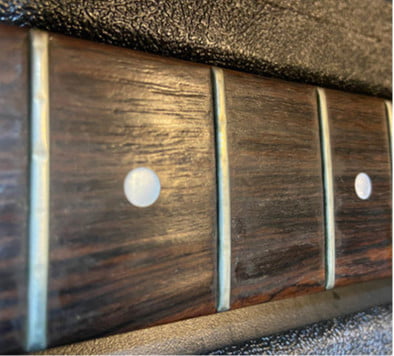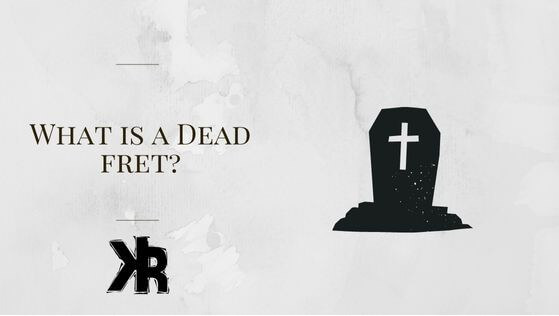Table of Contents
Ever notice that your guitar makes a buzzing when certain notes are played? This can often be caused by a dead fret. What is a dead fret, you may ask?
A fret is considered dead when the note can no longer be heard clearly. It normally results in a complete lack of sustain, or sometimes doesn’t make a sound at all.
As far as dead frets go, there is a lot to know about them. Many guitarists have questions like what causes them, or whether they can be fixed.
In this Killer Rig article, we are going to explore what this means. We will also look at what can be done to fix a dead fret.
What is a Dead Fret?
The frets on your guitar are there to help you play a note. When you press on them and play the string, a sound is produced. It’s expected that the sound will be clear and ring out. But when a fret gets dented or damaged, the sound will be affected negatively.
A dead fret on a guitar is a fret that doesn’t produce the intended note or sound when pressed. Instead, you might hear a buzzing, muted, or inconsistent tone. This issue can disrupt the flow of playing and make certain songs or techniques difficult to execute properly.
How Do You Identify a Dead Fret?
Identifying a dead fret requires a keen ear and some investigative work. There are other factors like intonation or action that can also cause the same issue. Here’s how you can identify a dead fret:
- Play Each Note: Slowly play each note on every string, paying close attention to any that sound off.
- Listen for Buzzing: A common symptom of a dead fret is a buzzing sound when you try to play the note.
- Check for Muted Tones: If the note sounds muted or softer than the surrounding notes, that’s another indicator.
- Repeat in Different Positions: Sometimes, a fret might only be dead when played in conjunction with other frets or strings. Make sure to check the fret in different positions and configurations.
Why Does It Matter?
A dead fret can disrupt your playing, making it difficult to produce the music you intend. It’s not just an annoyance; it can seriously hinder your performance and even cause you to develop bad habits as you try to compensate for the faulty fret.
If you find yourself dealing with a note that won’t ring true, you might be facing a dead fret. It’s a problem that requires attention, whether you’re a casual player or a dedicated musician.
What Does a Dead Fret Sound Like?
The one way to know if you have a fret issue is when the guitar string sounds dead when fretted. This can be described as:
- Note can’t be heard when played
- Decays very rapidly
- Has a very tinny buzz sound and no sustain
These sounds are very evident and are very frustrating for a guitarist. Once this starts to happen, either a refret is required or a leveling service.
What Causes Dead Frets
There are a number of ways that a dead fret can occur. Make sure to look out for all these things if you suspect that you have a dead fret on your guitar.
First, you could have uneven or loose frets. A guitar’s string needs to vibrate clearly and without interference. Yet, if that fret is loose and touching the string, it could make it sound muted or buzz badly. This creates the dead fret sound, as the string’s vibration is being interfered with.
Your guitar’s fretboard could also be warped. There could be a hump somewhere along the neck. It could interfere with the proper vibration of the string.
This, like a loose fret, can cause that awful sound. It’s quite common for guitar necks to bow or for fretboards to become arched or humped.
As mentioned above, a bowed neck could be the issue. This isn’t just the fretboard, but the rest of the neck as well. This often means your truss rod (the metal rod inside your guitar’s neck) needs to be adjusted.
Finally, your strings might be too old! Old strings can be shaped irregularly and sound unclean. This would lead to a similar muted or buzzing on certain guitar frets, causing them to sound dead. This is the easiest issue of all to fix and should be a part of regular guitar maintenance.
Sympathetic Resonance
There is another cause of a dead fret that is somewhat rare and strange. But worth mentioning, especially if they look good. Sympathetic resonance occurs when a note causes another part to vibrate. Normally at the same pitch.
When the two parts vibrate together at the same frequency, they cancel each other out. This is done by absorbing energy which causes a lack of sustain, or a dead note sound.
This is more common in acoustic and hollow-body guitars. But should be considered when chasing down a dead fret. This is normally caused by loose hardware or bracing, nuts, bridges, or the wood the guitar is made with.
The humidity levels changing can cause this as the guitar dries out. This can be hard to track down, but there are a few things you can do to see if this is the cause.
Down Tune The String
The first thing to try is to down-tune the string causing the issue. You want to change the pitch of the string so that it won’t resonate at the same frequency when the note is played.
Simply tuning the string down half a step to start is fine. Once you do, play the note at the same fret. If it doesn’t die off or buzz as it did before, you have a sympathetic resonance issue.
If it does die off again like before, tune the string down another step and try again. When this happens, then it’s a fret, neck relief, or action issue that needs to be inspected further. Yet, if it’s full of sustain like you would expect, then you need to find the offending part.

Do Some Maintenance
Doing some proper maintenance can’t hurt. And so you should snug up all steel fasteners and inspect the parts for looseness.
Maybe it’s loose bracing inside the guitar body. Then you may want to get a professional with the right tools involved. Glue joints may also be failing, which will need to be fixed before any further damage results.
You also might want to consider if the wood has dried out. This would cause sympathetic resonance issues. Sometimes it can be in the body or even the headstock.
You can try to clip a tuner onto the headstock to see if that fixes the problem, as it is common for this to happen here. But you should also check the humidity of your guitar. Start with the environment it is stored in, this will tell you if perhaps it is too dry.
How to Fix Dead Notes
There are ways to fix each of the issues listed above, so worry not if you have a fret that isn’t quite cooperating!
If you think a fret is loose, you must identify which one. Lightly jiggle each one with your fingers until you find the culprit. Then, remove your strings and place a towel under your guitar’s neck to cushion it.
After that, take a plastic, brass, or rubber hammer. Lightly knock the loose fret back into its seated position. If it doesn’t go back in snugly, you may have a cracked or warped fretboard to worry about.
If your fretboard is warped, there is the option to file down your frets. You can also get a new neck or fretboard. Reshaping a warped fretboard can be very risky, especially for inexperienced guitar tinkerers. This is often better left to professional luthiers.
If your guitar’s neck is bowed or angled, first take a capo and clamp down on the first fret, then press down the 14th.
Place a card at the 7th fret and see if it touches the strings. If it doesn’t, you have a truss rod to adjust! In order to adjust it, take an Allen wrench and twist right to make it tighter, and left to make it looser.
If your guitar neck is warped or bowed too much (as in the wood itself) it will need to be replaced completely.
Dead Fret on New Guitar
What happens if you take possession of a new guitar and a string sounds lifeless when fretted? Then you need to contact the retailer and get it fixed.
A new instrument should never have issues like this and are a possible sign of a bigger issue. As we mentioned above, there are a few reasons why this might happen.
But if it is a new guitar, then it could have taken damage in shipping that may not be evident. In this case, don’t try and fix it yourself, but take it back to the merchant where it can be properly looked at and resolved.
Conclusion
It’s important to make sure that you are taking care of dead frets for a number of reasons. Firstly, it’s to make sure your guitar can do what it does best, play notes! However, that’s not the only reason.
A dead fret can often be a sign of deeper problems. Such as issues with the neck, fretboard, truss rod, and other parts of the guitar. If you can catch these issues early, they will be less expensive to fix, and oftentimes you can save your guitar!
Take dead frets, not as a minor inconvenience. But as a sign that something could be wrong with your guitar, you should try to fix it before it can’t be at all.

